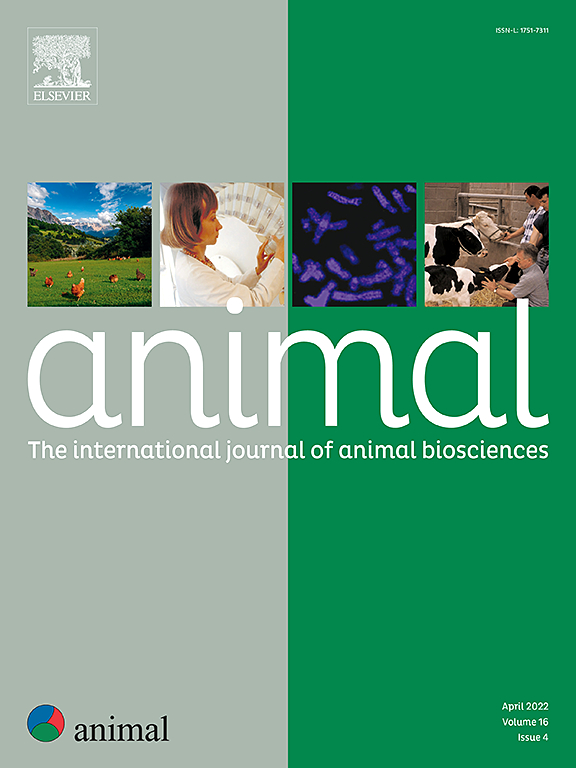Short communication: Genomic prediction based on unbiased estimation of the genomic relationship matrix in pigs
IF 4
2区 农林科学
Q1 AGRICULTURE, DAIRY & ANIMAL SCIENCE
引用次数: 0
Abstract
The traditional genomic relationship matrix (GRM) has shown to be a biased estimation of true kinship, which can affect subsequent genetic analyses. In this study, we employed an unbiased kinship (UKin) estimation method within the genomic best linear unbiased prediction framework to evaluate its prediction performance on both a simulated dataset and a Large White pig dataset. The simulated dataset encompasses six traits, 900 quantitative trait loci, and 36 000 single nucleotide polymorphisms (SNPs). Two scenarios (small effect genes; major genes and small effect genes) and three heritabilities (0.1, 0.3 and 0.5) were considered. The Large White pig dataset includes two traits, 3 290 animals and 35 172 SNPs. The prediction performance of the Ukin method was compared with several other GRM construction methods, including VanRaden1 and 2 methods, Goudet method, and the runs of homozygosity (ROH) method. In the simulated dataset, VanRaden2 method and the UKin+VanRaden1 method achieved relatively higher prediction accuracies, averaging 0.561 and 0.558 for the six traits, respectively. Apart from the ROH method, all methods demonstrated similar levels of unbiasedness, around 1.10. In the Large White pig dataset, the accuracy of two traits hovered around 0.780, and the unbiasedness around 0.99, again with the ROH method as an exception. This study underscores the potential of the unbiased kinship estimation method in animal breeding.
短通信:基于猪基因组关系矩阵无偏估计的基因组预测。
传统的基因组关系矩阵(GRM)已被证明是一个有偏见的估计真正的亲属关系,这可能会影响后续的遗传分析。在本研究中,我们采用基因组最佳线性无偏预测框架中的无偏亲属关系(UKin)估计方法来评估其在模拟数据集和大白猪数据集上的预测性能。模拟数据集包括6个性状、900个数量性状位点和36000个单核苷酸多态性(snp)。两种情况(小效应基因;考虑主效基因和小效基因)和三种遗传力(0.1、0.3和0.5)。大白猪数据集包括2个性状、3 290头猪和35 172个snp。将Ukin方法与VanRaden1和2方法、Goudet方法、run of homozygosity (ROH)方法等几种GRM构建方法的预测性能进行了比较。在模拟数据集中,VanRaden2方法和UKin+VanRaden1方法的预测精度相对较高,6个性状的平均预测精度分别为0.561和0.558。除ROH方法外,所有方法的无偏性都在1.10左右。在大白猪数据集中,两个性状的准确率徘徊在0.780左右,无偏性在0.99左右,同样是ROH方法的例外。这项研究强调了无偏亲属估计方法在动物育种中的潜力。
本文章由计算机程序翻译,如有差异,请以英文原文为准。
求助全文
约1分钟内获得全文
求助全文
来源期刊

Animal
农林科学-奶制品与动物科学
CiteScore
7.50
自引率
2.80%
发文量
246
审稿时长
3 months
期刊介绍:
Editorial board
animal attracts the best research in animal biology and animal systems from across the spectrum of the agricultural, biomedical, and environmental sciences. It is the central element in an exciting collaboration between the British Society of Animal Science (BSAS), Institut National de la Recherche Agronomique (INRA) and the European Federation of Animal Science (EAAP) and represents a merging of three scientific journals: Animal Science; Animal Research; Reproduction, Nutrition, Development. animal publishes original cutting-edge research, ''hot'' topics and horizon-scanning reviews on animal-related aspects of the life sciences at the molecular, cellular, organ, whole animal and production system levels. The main subject areas include: breeding and genetics; nutrition; physiology and functional biology of systems; behaviour, health and welfare; farming systems, environmental impact and climate change; product quality, human health and well-being. Animal models and papers dealing with the integration of research between these topics and their impact on the environment and people are particularly welcome.
 求助内容:
求助内容: 应助结果提醒方式:
应助结果提醒方式:


